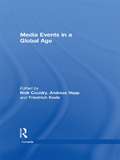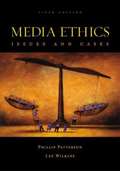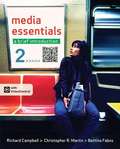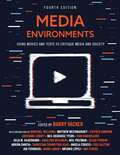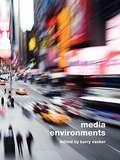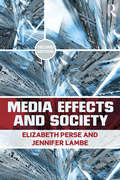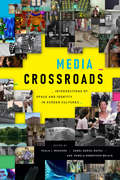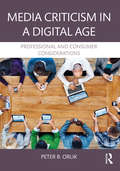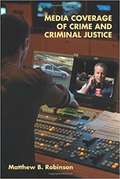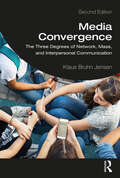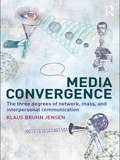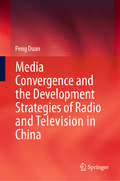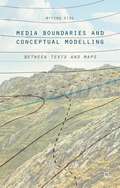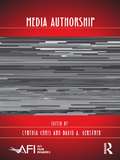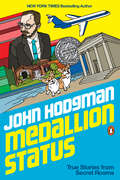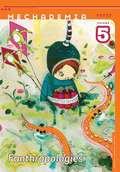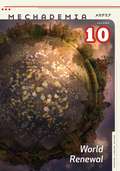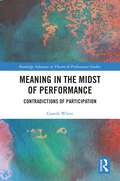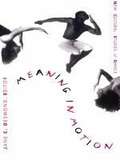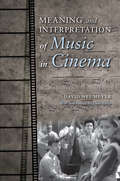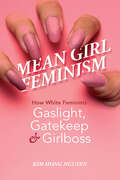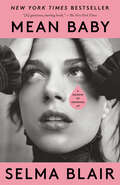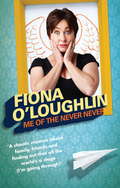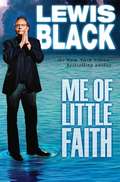- Table View
- List View
Media Events in a Global Age (Comedia)
by Andreas Hepp Nick Couldry Friedrich Krotz"This volume assembles an estimable range of critical analyses of one of the most important mediated artifacts of the modern world—the media event. The authors challenge the construct, extend its usefulness, expand its theoretical basis and application, and examine media events in a far larger and richer context than ever before. Students of global media today are well served by this superb collection of essays."David Morgan, Duke University, USA "A welcome and worthy successor to Dayan and Katz’s path-breaking study that expands and enriches the discourse on global media events." Daya Thussu, University of Westminster, UK "This is an excellent collection, that will enable new kinds of argument about, and hopefully research into, the spectacular functions of the contemporary media." Graeme Turner, University of Queensland, Australia We live in an age where the media is intensely global and profoundly changed by digitalization. Not only do many media events have audiences who access them online, but additionally digital media flows are generating new ways in which media events can emerge. In times of increasingly differentiated media technologies and fragmented media landscapes, the ‘eventization’ of the media is increasingly important for the marketing and everyday appreciation of popular media texts. The events covered include Celebrity Big Brother, 9/11, the Iraq war and World Youth Day 2005 to give readers an understanding of the major debates in this increasingly high-profile area of media and cultural research.
Media Ethics: Issues and Cases, 5th Edition
by Philip Patterson Lee WilkinsBy combining real-life and hypothetical cases with a succinct introduction to ethical theory, this text helps students prepare for the ethical situations they will encounter in the media professions. It is an ideal choice as the main text in a media ethics course or as a supplemental text in any course in journalism. The new edition reflects changes in the world post 9/11, including the war in Iraq, the Enron and WorldCom scandals, and a new look at media and democracy in light of FCC-approved media consolidation.
Media Essentials: A Brief Introduction (Second Edition)
by Richard Campbell Christopher Martin Bettina FabosMedia Essentials focuses on the fundamentals of mass communication, helping students keep pace with today's rapidly evolving and converging media. Best-selling authors Richard Campbell, Christopher R. Martin, and Bettina Fabos distill the essential information on media industries and major concepts, incorporate their accessible critical approach, and give students all the study tools they need to succeed in the course and be savvy media consumers. For the second edition of Media Essentials, the authors have added and enriched coverage of media topics instructors asked for, including videogames, convergence, media literacy, streaming music, online journalism, and more. This all comes together in a brief, attractive format -- for a very attractive price, about 50% less than competing texts.
Media Environments: Using Movies and Texts to Critique Media and Society
by Barry VackerMedia Environments: Using Movies and Texts to Critique Media and Society uses popular film as a gateway to critical readings, encouraging students to think creatively and critically about media, society, technology, and popular culture. <P><P>The text explores media in their totality and provides models and theories for interrogating many universal themes that span media, technology, and planetary civilization. Using popular films about media as lead-ins, students are introduced to the works of well-known thinkers and writers such as Marshall McLuhan, Charlton D. McIlwain, Shoshanna Zuboff, Julia Hildebrand, Neil deGrasse Tyson, Devon Powers, Antonio Lopez, and many others.
Media Environments
by Barry VackerMedia Environments is based on a simple concept: combine movies with texts to critique media and society in the 21st century. That's right, movies and texts. But this is not edutainment! This anthology uses popular film as a gateway to critical readings, culled from the works of a variety of well-known thinkers, scholars, and writers. Authors include Stephen Hawking, Al Gore, Naomi Klein, Carl Sagan, Naomi Wolf, Susan Jacoby, Neil Postman, Henry Jenkins, Neil deGrasse Tyson, Ray Kurzweil, and many others. Their writings are introduced to students through films like The Social Network, Contact, Network, American Beauty, Fight Club, The Truman Show, Slumdog Millionaire, Waking Life,WALL. E, Good Night, and Good Luck, and many others.
Media Effects and Society (Routledge Communication Series)
by Elizabeth M. Perse Jennifer LambeGrounded in theoretical principle, Media Effects and Society help students make the connection between mass media and the impact it has on society as a whole. The text also explores how the relationship individuals have with media is created, therefore helping them alleviate its harmful effects and enhance the positive ones. The range of media effects addressed herein includes news diffusion, learning from the mass media, socialization of children and adolescents, influences on public opinion and voting, and violent and sexually explicit media content. The text examines relevant research done in these areas and discusses it in a thorough and accessible manner. It also presents a variety of theoretical approaches to understanding media effects, including psychological and content-based theories. In addition, it demonstrates how theories can guide future research into the effects of newer mass communication technologies. The second edition includes a new chapter on effects of entertainment, as well as text boxes with examples for each chapter, discussion of new technology effects integrated throughout the chapters, expanded pedagogy, and updates to the theory and research in the text. These features enhance the already in-depth analysis Media Effects and Society provides.
Media Crossroads: Intersections of Space and Identity in Screen Cultures
by Paula J. Massood, Angel Daniel Matos, and Pamela Robertson WojcikThe contributors to Media Crossroads examine space and place in media as they intersect with sexuality, race, ethnicity, age, class, and ability. Considering a wide range of film, television, video games, and other media, the authors show how spaces—from the large and fantastical to the intimate and virtual—are shaped by the social interactions and intersections staged within them. The highly teachable essays include analyses of media representations of urban life and gentrification, the ways video games allow users to adopt an experiential understanding of space, the intersection of the regulation of bodies and spaces, and how style and aesthetics can influence intersectional thinking. Whether interrogating the construction of Portland as a white utopia in Portlandia or the link between queerness and the spatial design and gaming mechanics in the Legend of Zelda video game series, the contributors deepen understanding of screen cultures in ways that redefine conversations around space studies in film and media.Contributors. Amy Corbin, Desirée J. Garcia, Joshua Glick, Noelle Griffis, Malini Guha, Ina Rae Hark, Peter C. Kunze, Paula J. Massood, Angel Daniel Matos, Nicole Erin Morse, Elizabeth Patton, Matthew Thomas Payne, Merrill Schleier, Jacqueline Sheean, Sarah Louise Smyth, Erica Stein, Kirsten Moana Thompson, John Vanderhoef, Pamela Robertson Wojcik
Media Criticism in a Digital Age: Professional And Consumer Considerations
by Peter B. OrlikMedia Criticism in a Digital Age introduces readers to a variety of critical approaches to audio and video discourse on radio, television and the Internet. It is intended for those preparing for electronic media careers as well as for anyone seeking to enhance their media literacy. This book takes the unequivocal view that the material heard and seen over digital media is worthy of serious consideration. Media Criticism in a Digital Age applies key aesthetic, sociological, philosophical, psychological, structural and economic principles to arrive at a comprehensive evaluation of programming and advertising content. It offers a rich blend of insights from both industry and academic authorities. These insights range from the observations of Plato and Aristotle to the research that motivates twenty-first century marketing and advertising. Key features of the book are comprised of: multiple video examples including commercials, cartoons and custom graphics to illustrate core critical concepts; chapters reflecting today’s media world, including coverage of broadband and social media issues; fifty perceptive critiques penned by a variety of widely respected media observers and; a supplementary website for professors that provides suggested exercises to accompany each chapter (www.routledge .com/cw/orlik) Media Criticism in a Digital Age equips emerging media professionals as well as perceptive consumers with the evaluative tools to maximize their media understanding and enjoyment.
Media Coverage of Crime and Criminal Justice
by Matthew RobinsonMedia Coverage of Crime and Criminal Justice critically examines the media to identify how crime and criminal justice are treated in the news and entertainment media. The goal is not only to help shed light on important realities of crime and criminal justice in the United States but also to correct major misconceptions created by coverage of crime and criminal justice in the news, on television, in movies, in music, and other media forms. While there are other texts on the market focused on the impact of mass media on criminal justice, this text is the only one that starts with the issue of corporate ownership of the mass media as a potential problem for gaining an accurate understanding of the realities of crime and criminal justice. Further, this text presents basic information about the media in the introductory chapters and then applies this information to specific issues of crime and criminal justice in the rest of the book, thereby focusing on the same issues and themes throughout the book. Topics analyzed include how the media are organized, how they operate, and to what degree citizens are exposed to the media. Additionally, the book analyzes competing explanations of media coverage of crime and criminal justice, using examples from the real world to show why the media cover topics (and ignore others) the way they do. The book deals with media coverage of law-making and crime, policing, courts, and corrections. There are separate chapters of media coverage of each branch of criminal justice, with reviews of the literature focused on the most recent and influential research on these topics. The book also examines how the media both help and hinder effective crime control and crime prevention efforts. The book concludes with a summary of the book as well as suggestions for media reform, based on major findings of the book.
Media Convergence: The Three Degrees of Network, Mass, and Interpersonal Communication
by Klaus Bruhn JensenThis second edition furthers conversations about the ongoing society-wide and worldwide digitalization of human communication. Reviewing the long lines in the history of media and communication – from writing via printing and broadcasting to computing – the book lays out three general types of media: the human body enabling face-to-face communication here and now; the technically reproduced means of mass communication across space and time; and the digital technologies integrating one-to-one, one-to-many, as well as many-to-many interactions. All these communicative practices coexist in contemporary media environments. Across cultures, genders, and age groups, people go on communicating in the flesh, via wires, and over the air, as illustrated though case studies of mobile communication on mundane matters, and of climate change as a global challenge for human communication and coexistence. The second edition includes: Updated accounts of research and public debate on digital media and communication Analyses of current social media and an emerging internet of things Systematic presentations of digital as well as traditional empirical methods Discussion of the normative implications of digitalization, including the classic rights of information and communication, and a right not to be communicated about through surveillance Interdisciplinary in scope to showcase the wide-reaching cultural consequences of media convergence, this book is ideal for advanced undergraduate students, graduate students, and scholars in the fields of media, communication, and cultural studies.
Media Convergence: The Three Degrees of Network, Mass and Interpersonal Communication
by Klaus Bruhn JensenThe development of digital media presents a unique opportunity to reconsider what communication is, and what individuals, groups, and societies might hope to accomplish through new as well as old media. At a time when digital media still provoke both utopian and dystopian views of their likely consequences, Klaus Bruhn Jensen places these ‘new’ media in a comparative perspective together with ‘old’ mass media and face-to-face communication, restating the two classic questions of media studies: what do media do to people, and what do people do with media? Media Convergence makes a distinction between three general types of media: the human body enabling communication in the flesh; the technically reproduced means of mass communication; and the digital technologies facilitating interaction one-to-one, one-to-many, as well as many-to-many. Features include: case studies, including mobile phones in everyday life, the Muhammad cartoons controversy and climate change as a global challenge for human communication and political action diagrams, figures, and tables summarizing key concepts beyond standard ‘models of communication’ systematic cross-referencing. Major terms are highlighted and cross-referenced throughout, with key concepts defined in margin notes.
Media Convergence and the Development Strategies of Radio and Television in China
by Peng DuanThis book discusses the development strategies of Chinese media convergence in the current, fast-changing communication environment. Drawing on both theoretical and empirical data and based on the author’s observations, focus groups, and in-depth analyses of selected Chinese radio and TV networks, it illustrates key lessons for the maintenance and future improvement of talents, advertisement, media organization management, business development, and coping strategies. Further, it outlines a framework that helps readers to consider how to use communication strategies for the construction of media convergence in the context of China by referring to theories of international communication and political communication.Presenting research on the development strategies of Chinese media convergence, it offers a systematic study of the processes through which the Chinese radio and television industries make use of proper communication strategies to have a profound global influence.
Media Boundaries and Conceptual Modelling: Between Texts and Maps
by Øyvind Eide<p>Media Boundaries and Conceptual Modelling forms part of the humanities tradition by facing one of the fundamental problems since antiquity: how different media represent the world we live in. It intersects also with the digital by addressing the problem with the help of a digital humanities method: computer assisted conceptual modelling. And it acknowledges the spatial turn by investigating the boundary between what has traditionally been the two main media for representation of geospatial information: texts and maps. <p>It contributes to the further development of digital humanities and bridges the two areas of digital humanities and intermedia studies. Further, it strengthens the theoretical foundation for research and teaching in spatial digital humanities. The book meets the lack of critical discussion of the practice of digital mapping, offering a theoretically based understanding of such practices from a humanities perspective. More generally, it contributes to the theoretical discussion of modelling in digital humanities.</p>
Media Authorship (AFI Film Readers)
by David A. Gerstner Cynthia ChrisContemporary media authorship is frequently collaborative, participatory, non-site specific, or quite simply goes unrecognized. In this volume, media and film scholars explore the theoretical debates around authorship, intention, and identity within the rapidly transforming and globalized culture industry of new media. Defining media broadly, across a range of creative artifacts and production cultures—from visual arts to videogames, from textiles to television—contributors consider authoring practices of artists, designers, do-it-yourselfers, media professionals, scholars, and others. Specifically, they ask: What constitutes "media" and "authorship" in a technologically converged, globally conglomerated, multiplatform environment for the production and distribution of content? What can we learn from cinematic and literary models of authorship—and critiques of those models—with regard to authorship not only in television and recorded music, but also interactive media such as videogames and the Internet? How do we conceive of authorship through practices in which users generate content collaboratively or via appropriation? What institutional prerogatives and legal debates around intellectual property rights, fair use, and copyright bear on concepts of authorship in "new media"? By addressing these issues, Media Authorship demonstrates that the concept of authorship as formulated in literary and film studies is reinvigorated, contested, remade—even, reauthored—by new practices in the digital media environment.
Medallion Status: True Stories from Secret Rooms
by John Hodgman“[An] affecting and hilarious meditation on fame and prestige as seen through the lens of an airline loyalty program.” —The AV ClubA hilarious and honest new book in which John Hodgman, New York Times bestselling author of Vacationland, leaves vacation behind and gets back to work as a still somewhat famous person . . . and then loses his jobAfter spending most of his twenties pursuing a career as a literary agent, John Hodgman decided to try his own hand at writing. Following an appearance to promote one of his books on The Daily Show, he was invited to return as a contributor. This led to an unexpected and, frankly, implausible career in front of the camera that has lasted to this very day, or at least until 2016.In these pages, Hodgman explores the strangeness of his career, speaking plainly of fame, especially at the weird, marginal level he enjoyed it. Through these stories you will learn many things that only John Hodgman knows, such as how to prepare for a nude scene with an oboe, or what it feels like to go to a Hollywood party and realize that you are not nearly as famous as the Property Brothers, or, for that matter, those two famous corgis from Instagram. And there are stories about how, when your television gig is canceled, you can console yourself with the fact that all of that travel that made your young son so sad at least left you with a prize: platinum medallion status with your airline.Both unflinchingly funny and deeply heartfelt, Medallion Status is a thoughtful examination of status, fame, and identity--and about the way we all deal with those moments when we realize we aren't platinum status anymore and will have to get comfortable in that middle seat again.
Mechademia 5: Fanthropologies (Mechademia #5)
by Frenchy LunningPassionate fans of anime and manga, known in Japan as otaku and active around the world, play a significant role in the creation and interpretation of this pervasive popular culture. Routinely appropriating and remixing favorite characters, narratives, imagery, and settings, otaku take control of the anime characters they consume. Fanthropologies—the fifth volume in the Mechademia series, an annual forum devoted to Japanese anime and manga—focuses on fans, fan activities, and the otaku phenomenon. The zones of activity discussed in these essays range from fan-subs (fan-subtitled versions of anime and manga) and copyright issues to gender and nationality in fandom, dolls, and other forms of consumption that fandom offers. Individual pieces include a remarkable photo essay on the emerging art of cosplay photography; an original manga about an obsessive doll-fan; and a tour of Akihabara, Tokyo's discount electronics shopping district, by a scholar disguised as a fuzzy animal.Contributors: Madeline Ashby; Jodie Beck, McGill U; Christopher Bolton, Williams College; Naitō Chizuko, Otsuma U; Ian Condry, Massachusetts Institute of Technology; Martha Cornog; Kathryn Dunlap, U of Central Florida; Ōtsuka Eiji, Kobe Design U; Gerald Figal, Vanderbilt U; Patrick W. Galbraith, U of Tokyo; Marc Hairston, U of Texas at Dallas; Marilyn Ivy, Columbia U; Koichi Iwabuchi, Waseda U; Paul Jackson; Amamiya Karin; Fan-Yi Lam; Thomas Lamarre, McGill U; Paul M. Malone, U of Waterloo; Anne McKnight, U of Southern California; Livia Monnet, U of Montreal; Susan Napier, Tufts U; Kerin Ogg; Timothy Perper; Eron Rauch; Brian Ruh, Indiana U; Nathan Shockey, Columbia U; Marc Steinberg, Concordia U; Jin C. Tomshine, U of California, San Francisco; Carissa Wolf, North Dakota State U.
Mechademia 3: Limits of the Human
by Frenchy LunningDramatic advances in genetics, cloning, robotics, and nanotechnology have given rise to both hopes and fears about how technology might transform humanity. As the possibility of a posthuman future becomes increasingly likely, debates about how to interpret or shape this future abound. In Japan, anime and manga artists have for decades been imagining the contours of posthumanity, creating dazzling and sometimes disturbing works of art that envision a variety of human/nonhuman hybrids: biological/mechanical, human/animal, and human/monster. Anime and manga offer a constellation of posthuman prototypes whose hybrid natures require a shift in our perception of what it means to be human.Limits of the Human—the third volume in the Mechademia series—maps the terrain of posthumanity using manga and anime as guides and signposts to understand how to think about humanity&’s new potentialities and limits. Through a wide range of texts—the folklore-inspired monsters that populate Mizuki Shigeru&’s manga; Japan&’s Gothic Lolita subculture; Tezuka Osamu&’s original cyborg hero, Atom, and his manga version of Fritz Lang&’s Metropolis (along with Ôtomo Katsuhiro&’s 2001 anime film adaptation); the robot anime, Gundam; and the notion of the uncanny in Ghost in the Shell 2: Innocence, among others—the essays in this volume reject simple human/nonhuman dichotomies and instead encourage a provocative rethinking of the definitions of humanity along entirely unexpected frontiers. Contributors: William L. Benzon, Lawrence Bird, Christopher Bolton, Steven T. Brown, Joshua Paul Dale, Michael Dylan Foster, Crispin Freeman, Marc Hairston, Paul Jackson, Thomas LaMarre, Antonia Levi, Margherita Long, Laura Miller, Hajime Nakatani, Susan Napier, Natsume Fusanosuke, Sharalyn Orbaugh, Ôtsuka Eiji, Adèle-Elise Prévost and MUSEbasement; Teri Silvio, Takayuki Tatsumi, Mark C. Taylor, Theresa Winge, Cary Wolfe, Wendy Siuyi Wong, and Yomota Inuhiko.
Mechademia 10: World Renewal
by Frenchy LunningMechademia 10 revolves around a maelstrom of events: the devastation of 3/11—the earthquake, tsunami, and nuclear reactor crises—and the ongoing environmental disasters that have recently overtaken Japan. Because anime and manga have long proposed (and illustrated) alternative worlds—some created after catastrophes—it is fitting that this volume should consider this propensity for &“world renewal.&”Individual essays range widely, from a poetic and personal reflection on the ritual of tôrô nagashi (the lighting of floating paper lanterns that has traditionally commemorated souls lost in great public cataclysms, such as war) to a study of the various counterfactual histories written about the historical figure of Toyotomi Hideyoshi, a former peasant farmer who became a military dictator of feudal Japan. The book also includes an original manga, Nanohana, from the popular artist Hagio Moto, who is quoted as saying: &“I want to think together with everyone else about Fukushima and Chernobyl, about the future of the Earth, about the future of humankind, and to keep thinking moving forward.&”
Meaning in the Midst of Performance: Contradictions of Participation (Routledge Advances in Theatre & Performance Studies)
by Gareth WhiteBeing an audience participant can be a confusing and contradictory experience. When a performance requires us to do things, we are put in the situation of being both actor and spectator, of being part of the work of art while also being the audience who receives it, and of being both perceiving subject and aesthetic object. This book examines these contradictions – and many others – as they appear by accident and by design in increasingly popular forms of interactive, immersive, and participatory performance in theatre and live art. Borrowing concepts from cognitive philosophy and bringing them into a conversation with critical theory, Gareth White sharply examines meaning as a process that happens to us as we are engaged in the problems and negotiations of a participatory performance. This study will be of great interest to scholars and students of theatre and performance, intermedial arts and games studies, and to practising artists.
Meaning in Motion: New Cultural Studies of Dance
by Jane C. DesmondDance, whether considered as an art form or embodied social practice, as product or process, is a prime subject for cultural analysis. Yet only recently have studies of dance become concerned with the ideological, theoretical, and social meanings of dance practices, performances, and institutions. In Meaning in Motion, Jane C. Desmond brings together the work of critics who have ventured into the boundaries between dance and cultural studies, and thus maps a little-known and rarely explored critical site.Writing from a broad range of perspectives, contributors from disciplines as varied as art history and anthropology, dance history and political science, philosophy and women's studies chart the questions and challenges that mark this site. How does dance enact or rework social categories of identity? How do meanings change as dance styles cross borders of race, nationality, or class? How do we talk about materiality and motion, sensation and expressivity, kinesthetics and ideology? The authors engage these issues in a variety of contexts: from popular social dances to the experimentation of the avant-garde; from nineteenth-century ballet and contemporary Afro-Brazilian Carnival dance to hip hop, the dance hall, and film; from the nationalist politics of folk dances to the feminist philosophies of modern dance. Giving definition to a new field of study, Meaning in Motion broadens the scope of dance analysis and extends to cultural studies new ways of approaching matters of embodiment, identity, and representation.Contributors. Ann Cooper Albright, Evan Alderson, Norman Bryson, Cynthia Cohen Bull, Ann Daly, Brenda Dixon Gottschild, Susan Foster, Mark Franko, Marianne Goldberg, Amy Koritz, Susan Kozel, Susan Manning, Randy Martin, Angela McRobbie, Kate Ramsey, Anna Scott, Janet Wolff
Meaning and Interpretation of Music in Cinema
by David P. NeumeyerBy exploring the relationship between music and the moving image in film narrative, David Neumeyer shows that film music is not conceptually separate from sound or dialogue, but that all three are manipulated and continually interact in the larger acoustical world of the sound track. In a medium in which the image has traditionally trumped sound, Neumeyer turns our attention to the voice as the mechanism through which narrative (dialog, speech) and sound (sound effects, music) come together. Complemented by music examples, illustrations, and contributions by James Buhler, Meaning and Interpretation of Music in Cinema is the capstone of Neumeyer's 25-year project in the analysis and interpretation of music in film.
Mean Girl Feminism: How White Feminists Gaslight, Gatekeep, and Girlboss (Feminist Media Studies)
by Kim Hong NguyenWhite feminists performing to maintain privilege Mean girl feminism encourages girls and women to be sassy, sarcastic, and ironic as feminist performance. Yet it coopts its affect, form, and content from racial oppression and protest while aiming meanness toward people in marginalized groups. Kim Hong Nguyen’s feminist media study examines four types of white mean girl feminism prominent in North American popular culture: the bitch, the mean girl, the power couple, and the global mother. White feminists mime the anger, disempowerment, and resistance felt by people of color and other marginalized groups. Their performance allows them to pursue and claim a special place within established power structures, present as intellectually superior, substitute nonpolitical playacting for a politics of solidarity and community, and position themselves as better, more enlightened masters than patriarchy. But, as Nguyen shows, the racialized meanness found across pop culture opens possibilities for building an intersectional feminist politics that rejects performative civility in favor of turning anger into liberation.
Mean Baby: A Memoir of Growing Up
by Selma BlairSelma Blair has played many roles: Ingenue in Cruel Intentions. Preppy ice queen in Legally Blonde. Muse to Karl Lagerfeld. Advocate for the multiple sclerosis community. But before all of that, Selma was known best as … a mean baby. In a memoir that is as wildly funny as it is emotionally shattering, Blair tells the captivating story of growing up and finding her truth. <p><p> The first story Selma Blair Beitner ever heard about herself is that she was a mean, mean baby. With her mouth pulled in a perpetual snarl and a head so furry it had to be rubbed to make way for her forehead, Selma spent years living up to her terrible reputation: biting her sisters, lying spontaneously, getting drunk from Passover wine at the age of seven, and behaving dramatically so that she would be the center of attention. <p><p>Although Selma went on to become a celebrated Hollywood actress and model, she could never quite shake the periods of darkness that overtook her, the certainty that there was a great mystery at the heart of her life. She often felt like her arms might be on fire, a sensation not unlike electric shocks, and she secretly drank to escape. <p><p>Over the course of this beautiful and, at times, devasting memoir, Selma lays bare her addiction to alcohol, her devotion to her brilliant and complicated mother, and the moments she flirted with death. There is brutal violence, passionate love, true friendship, the gift of motherhood, and, finally, the surprising salvation of a multiple sclerosis diagnosis. In a voice that is powerfully original, fiercely intelligent, and full of hard-won wisdom, Selma Blair’s Mean Baby is a deeply human memoir and a true literary achievement. <p> <b>New York Times Bestseller</b>
Me of the Never Never: The Chaotic Life and Times of Fiona O'Loughlin
by Fiona O'LoughlinNothing turns out as you plan, I guess; but I often think if I'd gone to a fortune teller when I was at school and been told I'd marry a guy who makes false teeth, move to Alice Springs, have five kids and become a standup comedian; well, I would have been surprised to say the least.'Fiona O?Loughlin is certainly the funniest (and possibly one of the busiest) working mothers in Australia today: a stand-up comedian based in Alice Springs and Adelaide, she is on the road for most of the year, doing live performances, plus regular television appearances. Fiona has also had successful shows at the Edinburgh and Adelaide fringe festivals, the Just for Laughs Festival in Montreal and the Melbourne International Comedy Festival.This book contains her stories ? funny and sometimes sad ? about her upbringing as part of a large Irish-Catholic family on a wheat farm in South Australia, her chaotic and disorganised family life ever since, living in Alice Springs and making it as a stand-up comedian. She also talks of a darker side of the life of many performers ? alcohol.This book is for anyone who likes to laugh (and cry), who wants to read about a woman living her life on her terms.`O`Loughlin memoir is deep and honest, as she describes her love for her large family and her ordeal of struggling with alcohol addiction?? The NSW Writers Centre`Her memoir is charm personified in that it?s not only a fascinating journey through an Australian woman?s life, its candour and honesty is kind of heart-melting?- Australian Women Online`This is one which will raise a lot of laughs not least because she is one of those rare people who can see the funny side to everything life throws at her? - Weekend Notes
Me of Little Faith
by Lewis BlackwellIn more than two dozen essays that investigate everything from the differences between how Christians and Jews celebrate their holidays, to the politics of faith, to people's individual search for transcendence, Black explores his unique odyssey through religion and belief.
